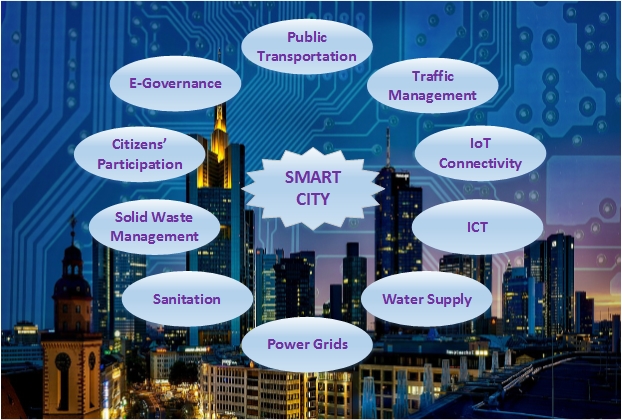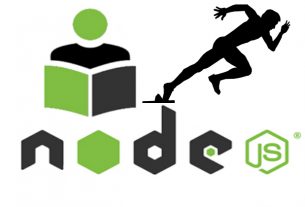A smart city is a new vision for civic design and development that brings together various segments of the society through the deployment of Internet of Things (IoT) and Distributed Computing technologies on a high speed network like 5G. The aim is to integrate and manage a city’s key functions such as transportation, commerce, education, health care, water and power supply, manufacturing, farming, law enforcement, waste management, and many more. The world’s cities are rapidly growing; new generations have new thoughts and priorities; hyper-globalization is revolutionizing how we build and deliver products and render services; and technological innovation is accelerating at a rapid rate. Therefore, the ultimate objective is to develop smart living environment, improve living conditions of the citizens, automate civic services and processes, develop open and transparent systems, and in general, build smarter and connected communities. The goal is to ensure that citizens’ needs are met in a smoother way and they are technologically empowered to positively affect the city’s functioning following a technologically led and
citizen-centered-governance approach.
With the passage of time the cities are becoming the focal point of economic prosperity, employment opportunities, education and health facilities, and conducive atmosphere for commercial and social activities. The government departments are also mostly situated in the cities. Better infrastructure for civic facilities like health care, education, entertainment, and transport etc., enhance people’s attraction to cities. Today, cities have become iconic symbols of development and prosperity. According to the global health observatory, urban population will be as much as 60% by 2030. That’s why, in the coming years, smart city management will be one of the key indicators of development and technical advancement of a country. Focus Group on Smart Sustainable Cities defines smart city as an innovative city that uses Information and Communication Technologies (ICTs) and other means to enhance the quality of civic life by making efficient the services of all kinds.
Apart from the cherished desire to use various technologies for the sake of automation, speed, transparency, and effectiveness, there are currently a range of serious challenges that our cities face that drive the cities to urgently move to the next levels of urbanization. These challenges include, but not limited to, the factors such as the increase in unemployment rate due to global economic crisis, pressure on housing sector due to growing demand, transportation and health care challenges due to enormous increase in population; changes in the climate in a negative manner; paradigm shift toward online entertainment and services; pressures on public finances and city resources due to increased awareness on the part of the common people; and the requirements to empower citizens to let them play their effective role in the development of the society through their active inclusivity.
Fortunately, the relevant computing technology landscapes, distributed computing paradigms, cloud and edge computing, IoT frameworks, and AI and high speed networks are already well established to achieve above mentioned objectives and empower the smart city officials as well as the citizens.
Nevertheless, there is still a lot to do in so many aspects; an urgent need for these technologies to be properly integrated taking into account the creation and utilization of big data, network and devices’ security, communication protocols, network bandwidth and topology; seamless connectivity, and worldwide regulations and legal compliance.
Smart cities represent large-scale, sophisticated, socio-technical, and socio-cybernetic systems which are inherently distributed, as well as, parallel processes. More so, Smart cities are one of the important application domains of the Internet of Things (IoT), in which smart devices of various kinds cooperate to provide better services for its citizens.
Key Role Player – IoT
A few years ago, people were only able to communicate and extract information using internet and ICT technologies. But with the advent of IoT, the things, that is the electronic devices are communicating with each other. These tiny devices are attached or embedded into the home and industrial appliances and let them “talk” to each other through the wireless network and make the appropriate decisions based on pre-defined set of instructions or what they have learnt from their own past experience.
Internet of Things (IoT) can be defined as “the ubiquitous presence around us, of a variety of well-connected things or objects such as Radio-Frequency Identification (RFID) tags, sensors, actuators, mobile phones, etc., which through unique addressing systems, are able to interact with each other and cooperate with their neighbors to reach common objectives in an efficient manner.

This ecosystem of interconnected things and the technology together have brought about enormous value. For example, the whole annual economic impact caused by the IoT based systems is estimated to be in as much as $6.2 trillion by the year 2025. Healthcare applications and related IoT-based services that enable medical well-being, prevention of diseases, diagnosis, treatment, and monitoring services to be delivered efficiently through electronic media are expected to create about $1.1–$2.5 trillion annually by the global economy by 2025. The technology experts speculate that by 2025, internet nodes may reside in everyday things like food packages, furniture, paper documents, wearable devices, home appliances, vehicles, automobile parts, buildings, literally every tangible thing which is of some value. Therefore, IoT is an all-encompassing jargon for a network backbone that will host billions of devices; sensors and actuators that intelligently communicate and take action.
The IoT connects all the noticeable surrounding objects to the Internet to make them more intelligent and automated so as to extract and deliver information where and when needed. Today IoT finds its applications on so many grounds.
Driver-less cars are no more a dream. When it’s time for office, the car starts up automatically, warms up the driver’s seat, and checks all necessary things; fuel, temperature, oil, electrical system, suspension, radiator function etc. If a fault is found, it immediately informs the driver. The ultimate edition of the smart car will be an autonomous car, getting you rid of all the hassles of the traffic, making your way to your destination. Every car will have RFID tags on it, which will help in improvising traffic management and prevent traffic jam. These RFID tags will send data to the central monitoring unit, through Edge or Fog infrastructure – which will analyze it and execute appropriate actions to keep the traffic system smooth and efficient.
Smart Homes concept has already turned to reality for a substantial period of time. For instance, you can use your smartphone to control your home even if you didn’t lock the gas valve or forgot to lock the front door when you go out. You can monitor and control your home appliances; fridge, air conditioner, microwave, electric lights etc. You can even leave them unattended and let the AI play its role to control them for you. You may need to setup them once manually. Setting up may require either to setup a date or time, and various sensors installed and connected so that whenever typical threshold condition occurs like temperature of geyser, or water tank filled with water, a predefined action is taken like power switched off, and an SMS or email is sent.
Smart street lights controlled by a central power grid can adjust their brightness according to the number of people in the area at a particular time. This helps the city management to conserve energy by switching off lights where it is not required. And all this is planned to happen automatically – based on the data constantly arriving from the scanners about the population and the activities in the particular areas.
IoT is about to play a key role in Smart Factories.
A lot of development has already been observed in this respect. Smart Factory is a future-oriented factory that combines information technology with manufacturing processes. A typical smart factory leverages IoT to significantly reduce the defect rate by allowing the computer system to determine whether the product is defective in each manufacturing process. The communication among IoT devices coupled with intelligent observation and decision making (Artificial Intelligence or AI) capability will effectively enable the manufacturing process to spot and prevent any fault to occur. This process may need little or no human intervention and hence a smart manufacturing comes into play.
Garbage collection and energy production is the key function of the modern Smart cities. Using a typical solution, a special chip-card based interface attached to the garbage containers, generates data which helps the planners to effectively determine the disposal pattern and suggest the best solution. The individual modules are then used to transport the waste to the treatment plants where-from the garbage is treated and then used in energy production. Thus, the role of air-polluting garbage trucks is eliminated.
Smart City Architectural Layers
Various architectures have so far been proposed in the course of the development of smart cities. It includes models that deal with various architectural layers, Service-Oriented Architecture (SOA), Event Driven Architecture (EDA), IoT and also hybrid architectures.
This is beyond the scope of this article to explain various architectures and their characteristics in details. In fact, regardless of the typical architectural design, every architecture consists of well-defined layers to provide a certain level of abstraction. This ensures a separation-of-concerns in order to keep the architecture maintainable and scalable by making various interacting layers loosely coupled but internally cohesive.
The commonly identified layers which are used by one or more of the aforesaid architectures are:
- The Information Layer which comprises the data collected from real time sensors, RFID and other IoT devices which are combined together using Geographical Information Systems (GISs).
- The Infrastructure Layer which consists of technologies, platforms and networks that are designed in collaboration in order to create and offer the services to the citizens and the government departments.
- The Service Layer which consists of the applications provided for the city and allows for interaction between citizens and government departments.
- The Management Layer which carries out statistical analysis, data mining and prediction techniques for managing the processed data and helping the system make automated on-the-fly decisions to prevent from any bottlenecks.
Service Oriented Architecture (SOA) is also a popular and common model and is deemed as one of the best building-block candidates for smart city. The primary objective of SOA is communication and interaction between the core services. The communication between various services in a computer system is implemented by data exchange among them. The services are designed to be unrelated, loosely coupled and self-sufficient so as to provide an efficient and maintainable system for the city.
Event Driven Architecture (EDA) has its own benefits when it comes to handle threshold levels or uneven situations. In EDA, creation, identification and response to events are handled. The events, when occur, handle the situations asynchronously. This architecture can also be combined with SOA. EDA is extremely useful to handle any unforeseen or out-of-the way conditions during the smart city services are in action, to prevent from any disaster or unwanted situation.
Challenges and Opportunities
The idea of smart cities is gaining rapid recognition and momentum due to their ability to provide quality living for the citizens along with taking into account the preservation of the natural environment. Implementing the concept of smart cities entails the incorporation of several technologies such as the Internet of Things (IoT), Information and Communication Technology (ICT), and high speed broadband networks like 5G. Such technologies, in collaboration with the state-of-the-art AI systems pave the way for the better functions and efficient governance of smart cities.
Recent years have seen an upsurge in technological advancement and expansion. On the other hand the human population growth has also increased at all time high rate. To make human life more organized, comfortable and secure along with sustainability of the environment, the concept of smart cities has been coined. Internet of Things (IoT) plays a vital role in smart city development by coalescing the activities of the physical world and the intellect of the computational world.
IoT provides a wider range of data transmission niches for development of sustainable smart cities. Ideally, smart cities are those that constantly monitor and combine the status of their infrastructures, governance, management, people and their belongings, health, education and natural environment using ICT. The design, construction and maintenance of smart city is done by using highly advanced integrated technologies, that include computing devices, sensors, actuators, and fast speed networks which are linked with computerized systems comprised of databases. With intelligent analysis and decision-making algorithms, being executed in the real-time, will enable the entire system to foresee any potential glitches and prevent them from happening.
The current ICT forms the fundamental parts of an effective smart city that include IoT, radio-frequency identification (RFID) devices, smart meters, semantic web, artificial intelligence, cloud computing, collective intelligence, smart applications, smartphone technology, biometrics and high speed 5G networks. Each participating technology mentioned here, is functionally distinctive in its design but is able to inter-operate within the entire infrastructure of the smart city to produce unified results.
The development of smart cities faces a number of serious hurdles like socio-economic and political issues but the greatest barrier is the technical issues. In technical aspect, the issue of security and privacy covers an important part along with the other issues such as system interoperability and cost-efficient technology. The issues of security and privacy of information are covered under the area of information security. The major objective of information security is to protect the information from attacks, hacks, frauds, and many other malignant activities that may cause damage either to the information, or intended malfunctioning of the system.
Implementation cost: Smart cities development involves technologies that are incurring a huge cost. Some cities which moved ahead to implement technologies with the ultimate objective of making just one or two functions of the city “smart” had to bear a huge cost. For example, the bus system in Copenhagen, Denmark, costs €125 million annually.
Future Prospects
By 2050 two-third of the world population will be living in cities. Urbanization is observed to be happening faster than ever before in the human history. Today, about more than 1 billion vehicles of all types, are already bringing urban areas to a standstill. Cities eat up three-quarters of the world’s energy each year and are responsible for about 50% of greenhouse-gas emissions.
This is where technology, data and intelligence are planned to work hand in golve to make better cities. Handling a huge number of things and objects that will be connected to the IOT through a high speed 5G network, leveraging AI to make smart decisions right on-the-fly – one step forward with newer technological innovations such as cognitive technology, contextual intelligence, context-aware applications, and fuzzy control systems, make future of smart city governance well in-control. Hence a technologically advanced smart city is not only an intelligent network of things, but it has the potential to gradually evolve into a network of networks, where devices of all types, sizes and functions; vehicles, smartphones, home appliances, toys, cameras, medical instruments, and industrial systems, and the citizens having smartphones all connected, communicating, and sharing and using information at all times. Above all, the decision making at most, if not all, levels will be delegated to the AI-based systems. This will enormously help tackle any emergencies and even prevent them from happening beforehand thus ensuring smooth running of
the smart city functions 24/7/365.
Smart cities are no longer the future thing. They are in place and growing quickly as the Internet of Things (IoT) expands and impacts municipal services around the globe. The smart city industry is speculated to be a $400 billion market by 2020, with 600 cities worldwide. These cities are expected to produce 60% of the world’s GDP by the next 5 years, according to McKinsey research.




